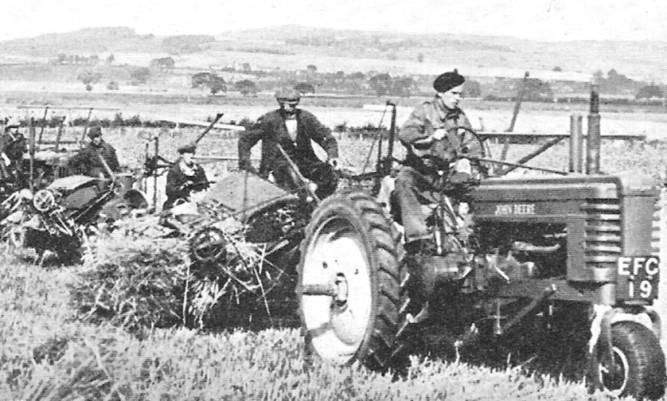The first successful John Deere tractor was a product of buying out the Waterloo Gasoline Engine Co and their Waterloo Boy tractor in 1918.
This led to their own design of tractor using the same twin-cylinder engine arrangement for their Model D in 1924.
Later there was a need for a row-crop tractor in response to the arrival of International Harvester’s revolutionary Farmall range. This led to a model C tractor, which eventually evolved into the GP Model produced in many variations including one aimed at potato growers.
By the 1930s design improvements were sought by the company and its customers. This led to the launch of a new tractor which was to be one of JD’s top machines for the next few years: the model A, first produced in 1934.
The A was designed as a straight replacement for the GP and offered more power, better driver visibility, a four-speed gearbox and independent rear-wheel braking.
It used a splined rear axle to facilitate easier wheel width changes.
It also had an option of a hydraulic lift, the first of its type. This straight up-and-down lift was not the same as Harry Ferguson’s three-point converging linkage that used draught forces for tractor adhesion.
This lift allowed John Deere to market a matching range of row-crop implements for the tractor, and front, mid and rear-mounted tool bars could be fitted for a wide variety of crops and operations.
The model came in a wide range of specifications, indicated by further letters added to the A of the model name.
The basic A was a three-wheel affair with a vee twin front wheel arrangement.
The AN had a single front wheel.
The AW was a four-wheel tractor with a wide full-width adjustable axle.
In due course other versions included the orchard A0 model and the AR, which had a standard non-adjustable full-width front axle.
High-clear versions were distinguished by adding the letter H to the previous model numbers used.
JD also made inroads into construction and industrial markets with an Industrial Model A turned out in highway yellow.
Many early models came out on steel wheels with spade lugs for grip.
Rubber tyres were also available, and many were shod on these using French and Hecht produced spoked wheels.
With the Model D still very much in production and the Model A suitable for row-crop work, smaller farmers were looking for a more compact, cheaper tractor capable of doing everything to replace their two horses.
John Deere responded with the Model B, announced in late 1934. This had all the same design features of the Model A but was smaller and less powerful.
All the US manufactures offered tractors for this expanding sector, such as the Allis Chalmers Model B, the Case R and the International F or W12.
The JD Model B was rated at 15HP compared to the A at 24HP, although the power ratings increased through the years.
The two tractors proved popular as row-crop machines or for open field operations or belt-pulley work.
John Deere offered favourable credit terms to American farmers to help them through the depression years one of the main reasons behind the customer loyalty it still benefits from today.
Variations of the type of Model A were mirrored in the Model B, with its original short frame extended in 1937 to give more room for mid-mounted implements hence the rarity of the earlier short-framed examples.
In 1938 it was thought sleeker lines would sell better as in the automobile industry and John Deere tasked Henry Dreyfuss with redesigning the look of its tractors.
His new designs were first seen on the Model A and B tractors before the other tractors in the JD range were modernised too. This has led to the old line being called unstyled and the new look examples as styled.
These John Deere tractors found plenty appreciative customers in the UK.
The earliest known JD dealer in the UK was FA Standen of St Ives in Cambridgeshire, who had actually sold the Waterloo Boy tractors, or Overtimes as they were known over here, during the First World War.
In 1934 they were appointed sole concessionaries for the UK
It is said that the post-war Standen Sugar Beet Harvesters were painted John Deere green and yellow because Standen had plenty of it in stock.
Changes in JD thinking in 1937 saw a restructuring in the UK. As JD and Caterpillar had a strong relationship, existing Caterpillar agents were also awarded the JD franchise. This led to Caterpillar agents Leverton of Spalding in Lincolnshire becoming important JD dealers.
Leverton’s were the Caterpillar agents for northern England and Jack Olding was the Caterpillar and subsequently the JD agent for the south and west.
The two came together to cover Scotland as LO Tractors at Coupar Angus in around 1938. Not only did they offer yellow Caterpillar equipment but also the green and yellow John Deeres which found favour in eastern Scotland because the row-crop design made them ideal for the seed potato industry, sugar beet, turnips and other forage crops grown in drills.
Indeed when LO launched the Angus Potato Digger, which was heavily influence by the John Deere Potato Hoover, it too was turned out in JD green and yellow.
The Second World War saw Lend-Lease introduced in 1941, and John Deere was one of many makes of US tractor to be shipped over the U-boat-menaced Atlantic to find a willing farming community desperate for any piece of farm machinery.
Along with tractors came the 12A trailed combine, toolbars, potato diggers, trailing ploughs, mowers, disc harrows and even some JD sugar beet harvesters.
Many farmers respected the well-made tractors with their distinctive ‘pop pop’ sound from the two-cylinder engine but after the war, with Britain’s inability to import dollar goods, the John Deere machines became unavailable.
